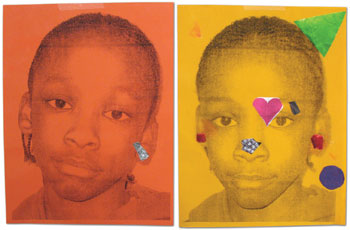| |
|

Christopher, a Mission Discovery student, combined Warhol’s silkscreen technique and Murals violence prevention curriculum to create self portraits. The portrait on the left is how he wants to be seen; the portrait on the right is how he feels inside.
Art Imitating Life
A new art project at Hill House-based Mission Discovery helps kids see the alternatives to anger and violence.
By Meghan Holohan
A dozen faces stare at a television. Black and white images flash on the screen. Laughter breaks out in the room and 11-year-old Sydney bows her head, covering her face with her hands.
Her friends in the Mission Discovery program at Hill House are watching Sydney mimic Andy Warhol’s famed Screen Tests on video during “game night” with the students and their parents. While Warhol’s muses looked straight into the camera, barely moving, Sydney giggles during her screen test, and her friends catch her infectious, onscreen laughter.
Sydney’s performance is part of a video chronicle of student projects conducted with The Andy Warhol Museum and Murals, a national program that addresses children’s social and emotional needs through art, music, dance, and drama. The students recently made screen tests to learn about Warhol’s art and to start a discussion about different members of the community and how they portray themselves to each other.
Sydney’s mother, Robin, shakes her head at her daughter, smiling. “This is a different type of mentoring,” she says. “It helps them to express emotions they couldn’t get out before.” Mission Discovery, in operation for five years, is an after-school and summer program based at Pittsburgh’s Hill House and run by Carnegie Science Center. Mayada Mansour, program coordinator, says it exposes middle-school students to art, science, technology, and culture through a partnership with all four Carnegie Museums.
But after a few years of working with the students, Mansour noticed that while they enjoyed after-school activities and visiting the museums, they were often dealing with the kinds of issues—like violence in the community or anger—that museum educators struggled to help them address. So Mansour tapped into the MGR Foundation’s Murals program, which provides students with the tools to oppose their exposure to violence—a huge social barrier that can prevent them from succeeding in life.
Murals came to Mission Discovery presenting two, six-week sessions—one for girls, the other for boys. The programs establish safe learning environments for students where they can freely discuss their thoughts without retribution, explains Phil Koch, director of the Murals program in Pittsburgh. Mansour also brought in volunteers from Big Brothers and Big Sisters of Greater Pittsburgh to increase adult participation during program sessions.
“Our foundation isn’t there to tell them how to live their lives. We try to show all the consequences of their actions,” Koch says. “Students don’t see the other options. They see people go directly to violence.”
In a recent session, students examined Warhol’s silkscreen images of icons Marilyn Monroe, Elvis Presley, and Jackie Kennedy. Koch and three educators from The Warhol—Nicole Dezelon, Bryan Lauch, and Ashley Brickman—explained how these stars influenced Warhol. Then Koch asked the children who influences them.
One girl says she admires Remy Ma, a rap star, but acknowledges that Remy Ma isn’t always a positive influence; the rapper talks about violence and drugs, yet she is a strong woman, she notes. Koch says projects like this help students address complexities in life and learn how to make smart choices.
After the discussion, educators from The Warhol and MGR Foundation artists Amy Garbark and Dale Harris help the students select and edit images of their heroes from the Internet, magazines, and books and turn them into silk-screens, so they can make pop portraits in the style of Warhol.
“The Murals staff was really good at creating dialogues around topics such as safe and unsafe images, and it’s been really great for us to be able to bring an art component to those discussions,” says Dezelon, assistant curator of education for school and teacher programs at The Warhol. “A successful collaboration is one where you also learn from one another, and I think that the Murals educators really got my gears turning in terms of how to talk about art in a way that is relevant to students.”
At game night, Reggie, a gregarious 14-year-old with big brown eyes and broad shoulders, proudly shows off art projects he and his classmates completed with Murals and The Warhol.
Canvases with copper and green splatters line the windows in the Mission Discovery kitchen area. Reggie explains that the students created oxidation paintings in the style of Warhol by using metallic paint on canvas and sprinkling vinegar on it to oxidize the paint. Warhol urinated on his paintings [to get a similar chemical reaction], Reggie confides.
When asked what he learned from the Murals project, Reggie says, “It teaches you what you shouldn’t be doing.” As he answers questions, he shoos others away, intoning that he is doing an interview.
“Let me tell you another story,” he says. The uninhibited Reggie goes on to explain how, in another Murals exercise, he and his friend Devonte shoved another kid in a locker because they said they didn’t like him. While the two laughed, enjoying their power, another group of students jumped them. This role-playing example showed Reggie and Devonte the consequences of bullying. Yet, Reggie admits that if he were ever bullied in real life, he might just punch the bully in the face. But he’d still tell the teacher.
Koch praises him for his honesty; no judgment in this room. Reggie knows he shouldn’t punch someone. But he might still do it. At least now he will consider the ramifications before acting.
“Kids need more and more positive influences,” says Sydney’s mother about the Murals program. “They need to know how to give and receive respect.”
|
|
 Summer 2007
Summer 2007

